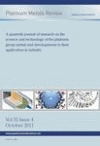-
oa Investigations on Platinum Gauze Surfaces Used in the Manufacture of Nitric Acid
The Dependence of the Activity of a Platinum Catalyst on the Composition of Sub-Surface Layers
- Source: Platinum Metals Review, Volume 44, Issue 2, Apr 2000, p. 74 - 84
-
- 01 Jan 2000
Abstract
The oxidation of ammonia for the production of nitric acid is a well known process which has been in constant use since the 1890s for the manufacture of fertiliser. Ammonia is oxidised on the surface of a woven or knitted catalyst gauze made of noble metals. Fertiliser production throughout the world partly depends on this technology and research is continuously being undertaken aimed at optimising output and reducing the noble metal loss from the catalysts. Here, some investigations carried out in Ukraine on the surface composition of binary (platinum-palladium) and ternary (platinum-palladiumrhodium) alloys used for the ammonia oxidation process are described. Samples of catalyst received different pretreatments, and their activity was then measured in a laboratory reactor, paying particular attention to the composition of the first few nanometres below the surface. Analysis of the experimental data showed that the role of carbon is different to that of other elements and that the activity of the catalyst is a maximum for carbon concentrations in the range 6 to 10 atomic per cent. It seems most probable than the carbon is present as microcrystals embedded in the alloy and concentrated on the faces of the metal crystals.


